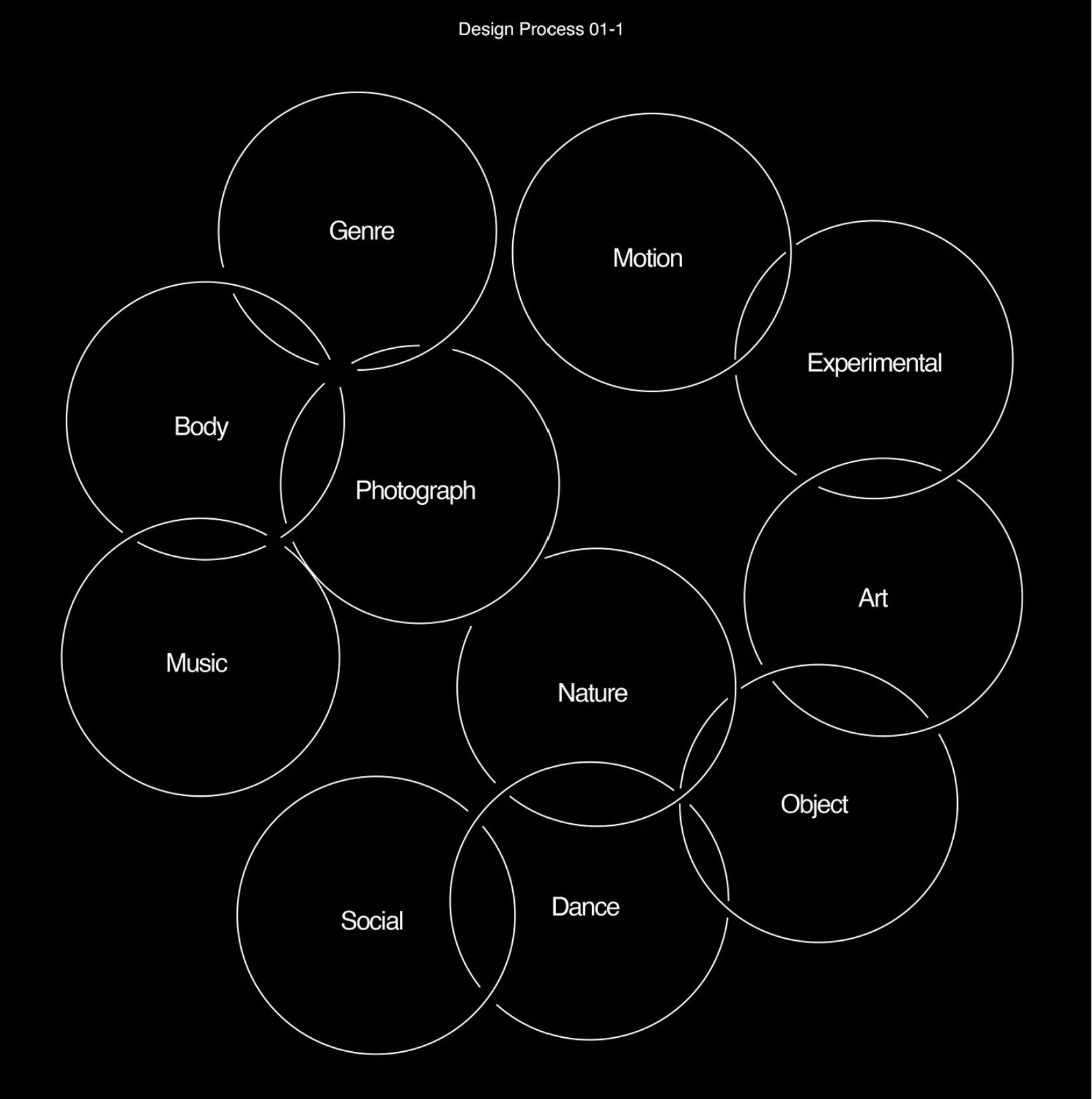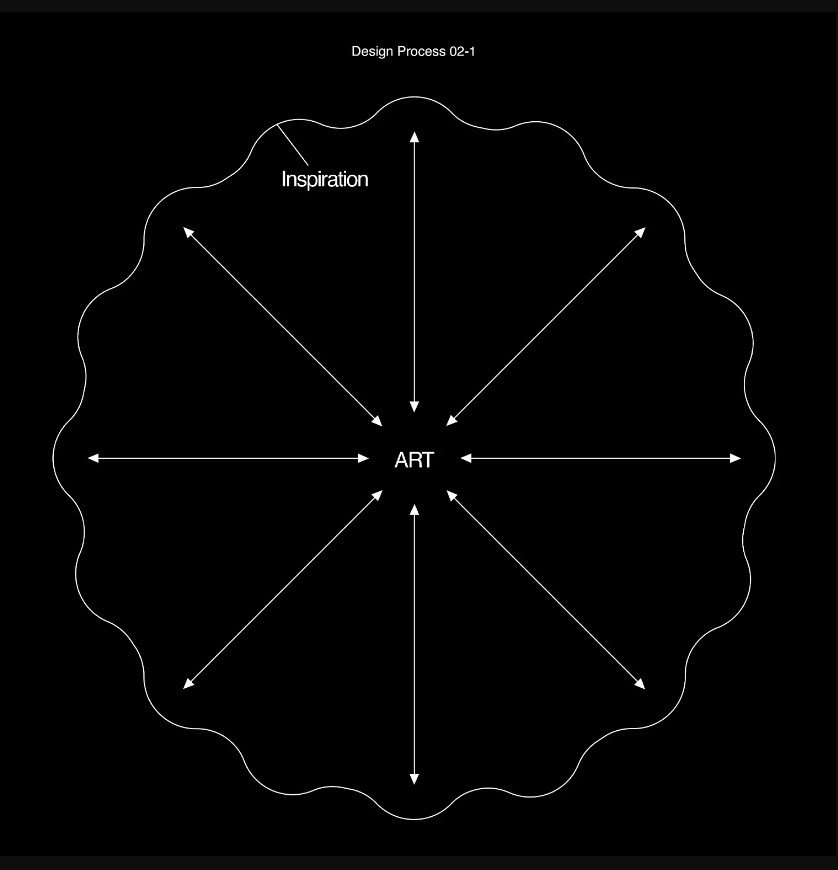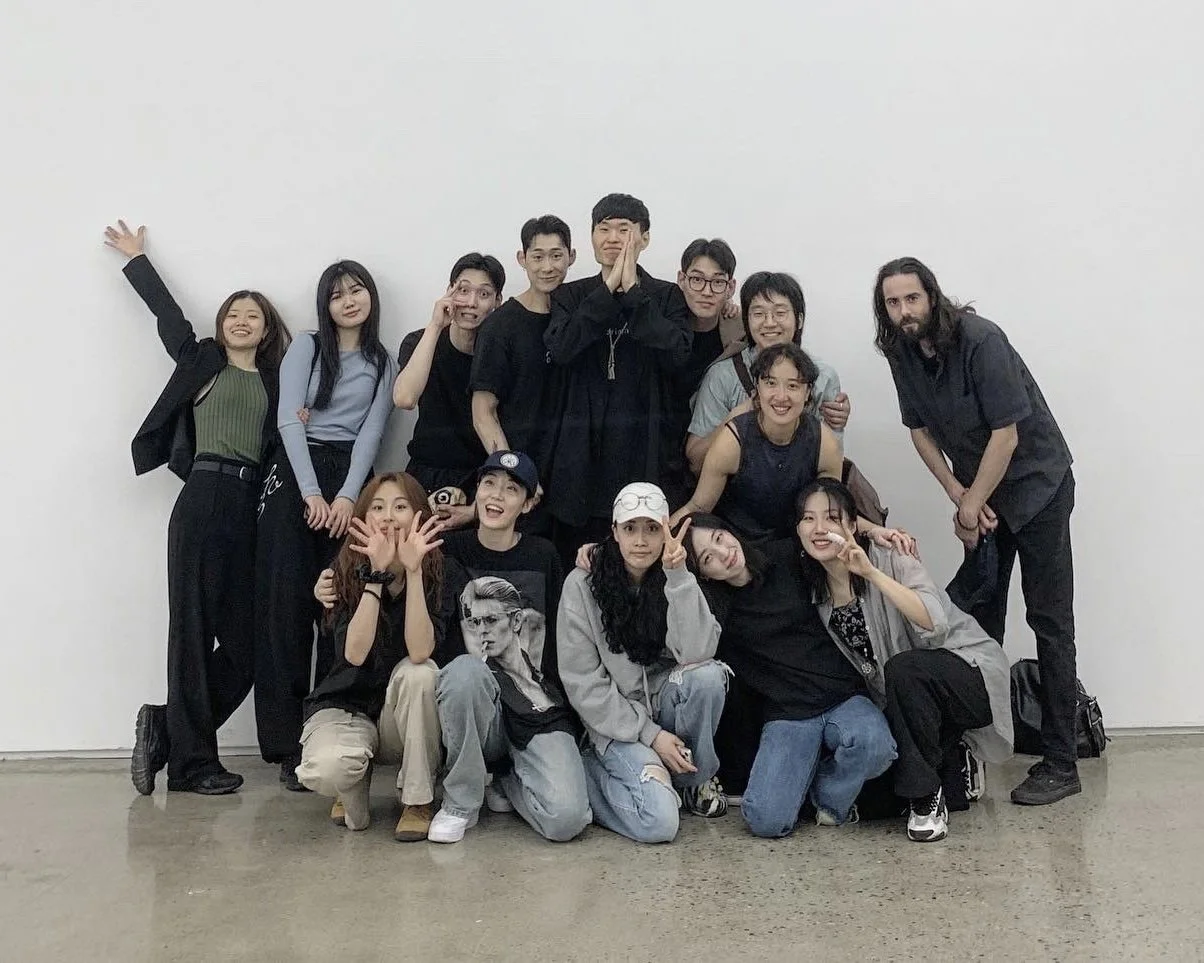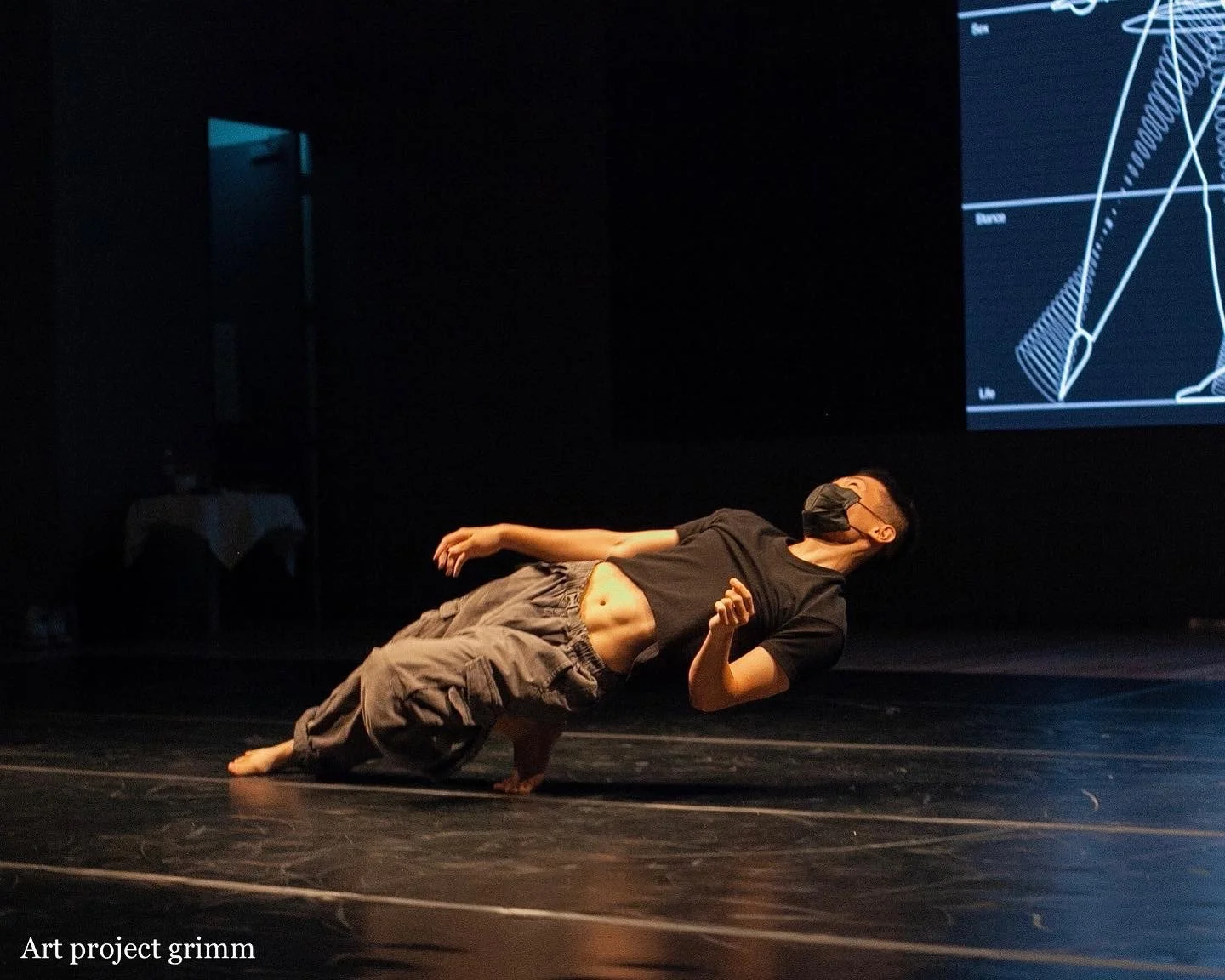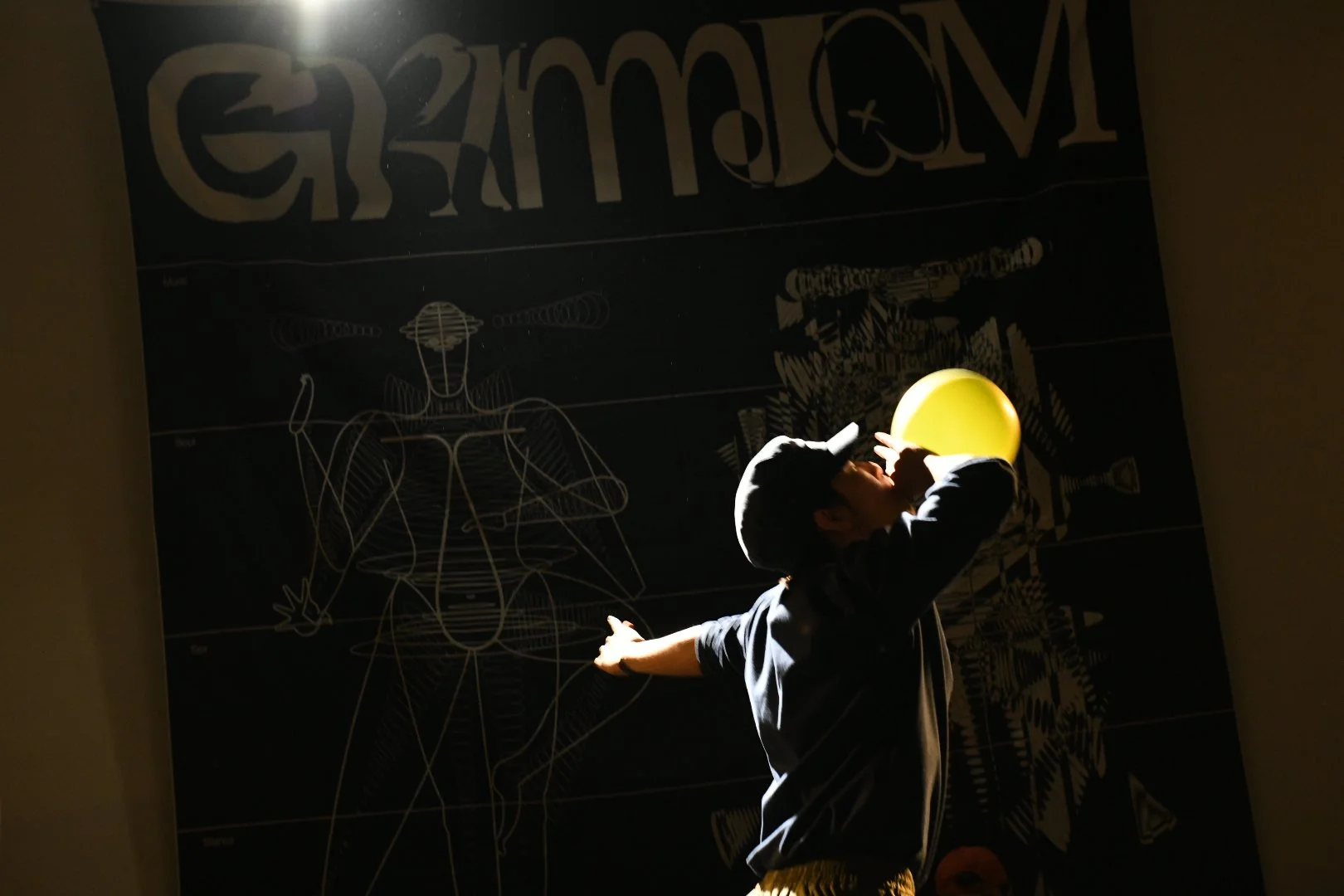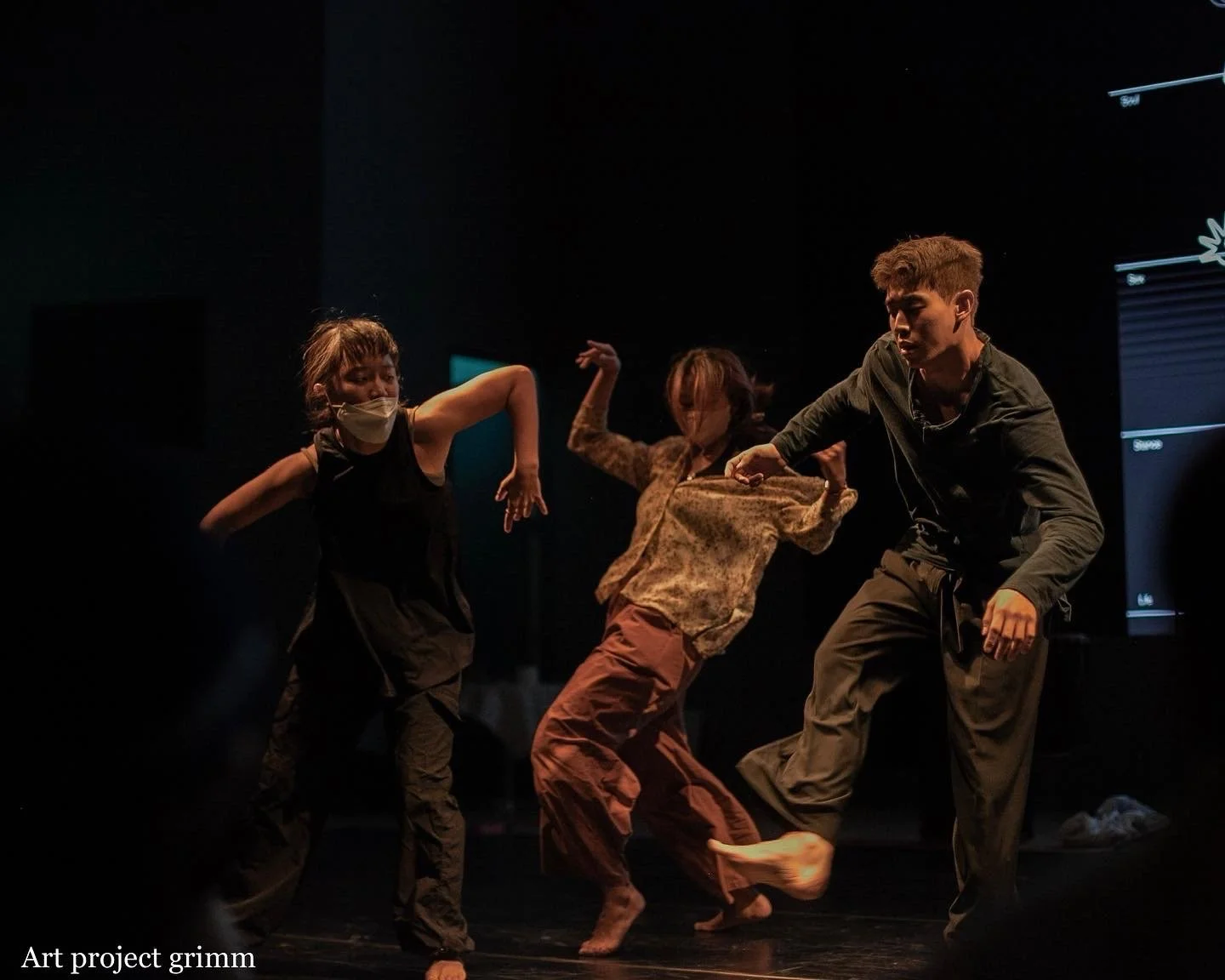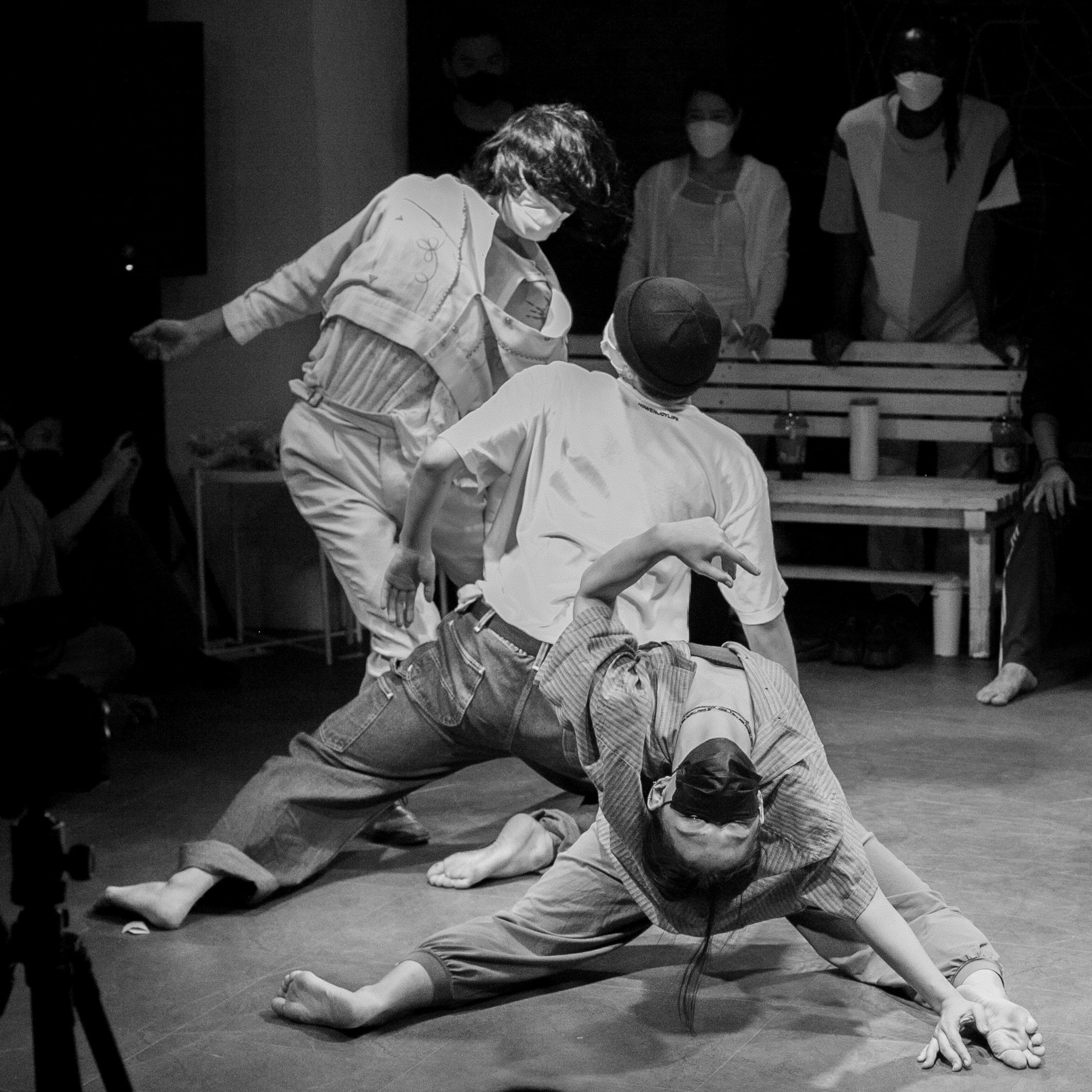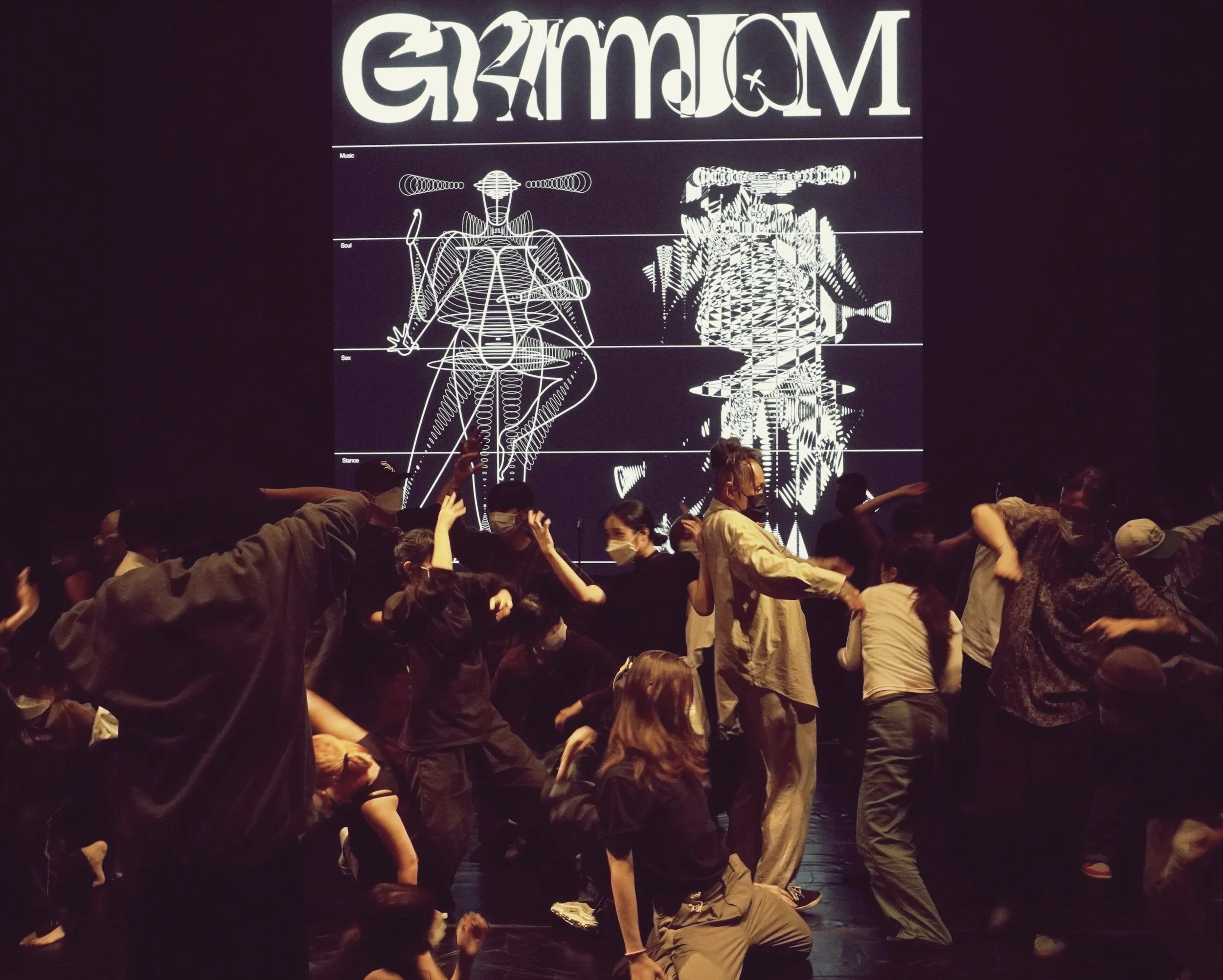EXPERIMENTAL DANCE COLLECTIVE IN SOUTH KOREA: GRIMM.B
by Dylan Goh | 13 October 2023
Interview with GRIMM.B member SOPHIKA
GRIMM.B (@grimmmtv) is an experimental dance collective which has been working in South Korea since 2020. They have 10 members including dancers (with backgrounds in ballet, contemporary dance, house and breaking), musicians and designers and their aim is to use dance as a medium to give and receive an array of artistic inspiration.
The experimental dance collective has delivered several performances, movement-based workshops, battles and jams within South Korea and internationally. GRIMM.B represents an alternative approach to movement which does not categorise itself according to the archetypes of a particular dance style, music or artistic form.
They are also the organisers of GRIMM JAM - the first experimental dance battle in South Korea - which is now in its 6th iteration. Regularly featuring over 120 participants from around South Korea, GRIMM JAM is a hybrid, 2-part event with a dance battle and jam. It is an event which embraces dancers who cannot / have no desire to define their movement according to a certain style.
A dance battle typically involves 2 individuals or 2 group who compete against each other. They improvise to random music within a short amount of time (30 seconds - 1 minute) in front of a panel of judges who decide the winner. Dance battles represent an intense exchange of energy between contestants which pushes them to showcase their technique, character and execution.
A jam is an informal gathering of dancers improvising together to music. Jams inspire creativity and build tight-knit communities as diverse participants dance and share their craft with each other.
“What we are doing is just showing or suggesting different forms of one’s own movement. Your movement is different. My movement is different.
Everyone has each role in this scene - like a puzzle. Everyone has beautifully different movement and way of expression. ”
Through an interview with GRIMM.B member SOPHIKA, this article covers:
Origins of GRIMM.B
History of experimental dance in Korea.
Running an experimental dance collective
Trajectory of experimental dance and GRIMM.B’s aspirations
ORIGINS OF GRIMM.B
With an emphasis on contemporary dance, GRIMM.B gathers diverse artists seeking to push lines of creative inquiry and resist limitations on expression imposed by particular genres, music and gender norms. The name GRIMM.B’ originates from two sources of inspiration:
The Korean term for drawing (그림 - geurim) resonated with early members of GRIMM.B who all happened to have a proficiency in drawing. It also incited connotations of drawing a movement with your body.
Brothers Grimm (Jacob and Wilhelm) were storytellers of fairy tales which inspired children worldwide and GRIMM.B members.
GRIMM.B was founded in 2017 by South Korean contemporary dancer Jeong Pilgyun who worked between Kassel and Bremen in Germany. In its early years, GRIMM.B’s members - composing dancers, actors, painters and musicians - created movement-based artworks and performed in churches, dance battles, bookstores and galleries. Once Jeong moved to New York in 2019 for a new job, the experimental dance collective also expanded its network of project collaborators. Finally in 2020 due to the COVID-19 pandemic, Jeong and GRIMM.B shifted operations back to Korea.
Jeong and ballet dancer Sohye Kim galvanised awareness of GRIMM.B in Korea by holding movement workshops. This brought together like-minded dancers and movement artists who make up the GRIMM.B team today. Further recruitment was conducted via word-of-mouth, Instagram and participation in GRIMM.B art projects to make up the 10 members in today’s team.
Grimm Art Brothers // Brand Experience Design, 2023. Photo: Owhyworks Co.
SOPHIKA recounts to meeting her diverse GRIMM.B members at her induction:
DYLAN:
What is a similar trait shared amongst GRIMM.B members?
SOPHIKA:
We’re just happy to meet similar people. GRIMM.B members are not defined by certain genres.
For example, I’m a house dancer and doing something weird. He’s a bboy and doing something weird. And in the scene, we are confused [as to where we fit]. So it was so funny when we first met and it was time for introductions.
“Simply tell us what you’re doing”
“WelI … I started bboying first but … I don’t know what I’m doing. I just love movement; I’m a dance lover.”
That was their introduction.
But the funny thing was those ten people all introduced themselves like that. They couldn’t really define themselves and they were aware that what there were doing was weird and not classical/typical.
There is still a member who has really classic movement and a concrete base in ballet, contemporary and Korean dance. But they are open to new ideas so we like to learn from movements from each other.
GRIMM.B team photo, 2023. Photo: GRIMM.B
SOPHIKA also comments on how she has become more open-minded after being part of this experimental dance collective.
DYLAN:
How has being in GRIMM.B changed you as a person?
SOPHIKA:
I’ve never met such a group which is this supportive and respectful towards one another. No one compares to each other because everyone already has so much experience. For example, half of the members have worked abroad - New York, Bremen, Italy - in a dance company and it’s quite a mature group - late 20s / early 30s.
Even if people disagree with ideas [when we work together], they don’t criticise or blame others. They listen and [work to] figure out a solution for everyone. Another important thing for this group is we don’t expect any compensation or reward. We gather to do what we like. We are interested in each other’s interests to give and receive inspiration [from each other].
“What do you like? Oh…you like that? Teach me.”
“Hey…how do you do that? Teach me.”
This open attitude to accept each other’s view - whatever it may be - has really changed me to become an open-minded person. To listen to others and respect their ways of expression - [GRIMM.B members] taught me this.
GRIMM JAM: VOL. 5 시도, 2022. Photo: Daian / 다옌
HISTORY OF EXPERIMENTAL DANCE IN KOREA
The concept of an experimental dance scene in Korea is relatively new. However, it has garnered significant interest over the past year with the explosion of experimental battles such as Gyeol, UMMAK (움막) and GRIMM JAM.
SOPHIKA describes the lack of a unified experimental dance scene:
DYLAN:
Before GRIMM.B, what was the history of experimental dance in Korea?
SOPHIKA:
The first time I saw experimental dance was in Juste Debout in France. It was all about bone breaking, creepy things and more technical and artistic b-boys and b-girls making physical experiments and unusual shapes. So I [also] thought in Korea there must have been bone breakers, voguers and people pursuing unusual movements. But I didn’t think there was an ‘experimental scene’ in Korea. Each group was just doing their own thing.
I heard GRIMM.B was the first group who actually mentioned and pursued ‘experimental movement’ at a battle. That’s why it was considered to be the first [experimental battle in Korea].
Only from last year, people started to ask [GRIMM.B] about our thoughts on the experimental dance scene. But we also thought, “What we are doing is experimental? What is the ‘experimental scene’? Do we have that in Korea?”
But after GRIMM JAM, there was Gyeol and UMMAK (움막) [led by Mad J, DOROCY and Hwaga] who really like these kinds of experiments. I could see the choreography and street dance scenes slowly mixing together. I could also see the younger generation becoming interested in a certain kind of movement which can’t be defined as street dance - but based on street dance.
Although I can see this shift and growth, I don’t think [the current state of experimental dance in Korea] is big enough to call it a ‘scene’. I hope this discussion and interview can be a middle check about how this movement is going and what it will become after a few years.
GRIMM JAM: VOL. 6 시도, 2023. Photo: Daian / 다옌
RUNNING AN EXPERIMENTAL DANCE COLLECTIVE
SOPHIKA describes how GRIMM.B makes unique teams on a project-by-project basis:
DYLAN:
Do you have regular recruitments for GRIMM.B?
SOPHIKA:
Not really.
But I think we have a different colour compared to other dance companies. We don’t have regular practices or performances (which we want) but we’re bonded [first and foremost] by intimacy.
So when there is a chance to make a short-term project, some people join. Next time, another group of people come together to make some work. When it comes to GRIMM JAM season, everyone comes together.
But we have online meetings all the time - 11 or 12 at night because everyone is always busy. We’re always trying to get any kind of opportunity for GRIMM.B to work with.
For example, in October, we will have a small unit for a local performance in Gangwon-do. In November, most of the members will join a performance at the National Museum. And then December - GRIMM JAM. So we naturally come together when there is a chance.
GRIMM JAM: VOL. 5 시도, 2022. Photo: Daian / 다옌
SOPHIKA elaborates on how an emphasis on compensation (as opposed to artmaking) would change the dynamic of the dance collection.
DYLAN:
You mentioned GRIMM.B members gather because they love movement and finding inspiration. If you had members intending to get a form of compensation or reward, how would that change the dynamic of the group?
SOPHIKA:
If we have those members, the image of this group would be very different. They would focus on work rather than art.
Of course, there must be pros and cons.
The pros are that GRIMM.B will be more goal-driven. We will have better careers and very visible outcomes to make this group more official.
But the cons are that not everything we do involves compensation and we are a big group. It's difficult to make work and money at the same time. So when we do something without compensation, some members won't join because we can't make money.
It's good to make money because of some activity. But if we expect some reward, the atmosphere, goal and scent of the work changes. I think this group works positively because every time we have a coincidence, it's a beautiful thing and the result is unexpectedly good.
GRIMM JAM: VOL. 4 시도, 2022. Photo: Daian / 다옌
TRAJECTORY OF EXPERIMENTAL DANCE AND GRIMM.B’S ASPIRATIONS
SOPHIKA optimistically looks forward to more diverse expressions of movement within Korea’s genre-segregated dance scene.
DYLAN:
What is the role of GRIMM.B and GRIMM JAM within the wider Korean dance scene?
SOPHIKA
What we are doing is just showing or suggesting different forms of one’s own movement. Your movement is different. My movement is different. Everyone has each role in this scene - like a puzzle. Everyone has beautifully different movement and way of expression.
If we keep showing what we are doing, we can suggest a new way of expression and make this scene more diverse. We can break the boundary between street and classical dance so people won’t judge us like, ‘Is that street or contemporary dance?’ They will just look at it.
We are in the middle of it in Korea. A few years later, I hope we can connect to the worldwide flow such as in Europe and other countries where they have a street dance, experimental and performing art scenes. Maybe it can happen in Korea too.
She also addresses tensions between cultural appropriation and experimentation with movement.
DYLAN:
But what are your thoughts on the challenges of cultural appropriation and experimenting with different styles (e.g. vogue and hip hop) as you pursue your own style?
SOPHIKA:
That’s a very sensitive topic because I’ve met dancers who ask: “What is that style?” And I’m like, “I don’t know. I just dance.” I can’t really say if it’s good or bad. It’s just a trial of one type of movement.
It’s okay to go out to the boundary and it’s also important to stick to one certain form of movement. Otherwise, the original will be gone and we will never know where it came from.
So some should stick to the original. Some should stick to the middle. And some should go out. Everyone has their own role and goal. I think this is the balance of the world.
For me, I can’t help but try something new. I don’t want to stick to one way of movement. I’m interested in discovering new types of movement based on house dance foundations. But someone else may go deeper into research to make more variations of original movements.
GRIMM JAM: VOL. 5 시도, 2022. Photo: Daian / 다옌
Finally, SOPHIKA identifies money and specialised staff as the key resources required to grow GRIMM.B.
DYLAN:
In terms of growing the experimental dance scene, what support (e.g. grants from the government) would you require?
SOPHIKA:
Funds or government support - particularly for the dance scene - is so important for dancers to give performances officially because we don’t have money. For example, I personally received government support last year which allowed me to work artists from the Netherlands.
[GRIMM.B members] also just want to focus on dance. But in this group for a performance or battle, we have to do everything at the same time. We always have to be dancers, producers, translators, MCs, graphic designers and even lighting designers.
So for GRIMM JAM, even if we have 10 members, that’s not enough. In Korean we say, 손이 모자란다 - we need hands. All the members want to dance on stage but we can’t do that because we have to be the light controller or sound designer - engineering roles.
If recruitment for designers, sound teams, engineering teams, main control teams, managers, daily staff, dancers and artists becomes official and structured, we can make a better-quality event.
GRIMM JAM: VOL. 6 시도, 2023. Photo: Daian / 다옌
Emerging dancers within Korea’s genre-segregated dance scene will continue to grapple with many challenges as they explore their own identity and movement as dancers. They will be judged by others seeking to categorise their dance. They will experience a sense of confusion while interrogating the essence of their dance. And they will rub up against issues of cultural appropriation as they experiment with an array of stylistic influences.
And within this context, experimental dance collectives like GRIMM.B and events like GRIMM JAM will continue to offer a safe space for dancers to explore these alternative expressions of movement. The future of Korea’s dance scene is one of diversity.


